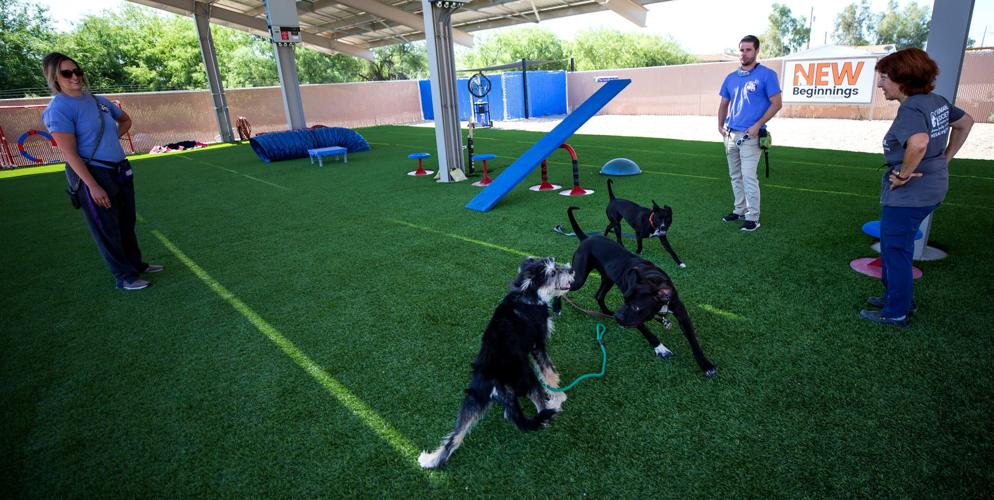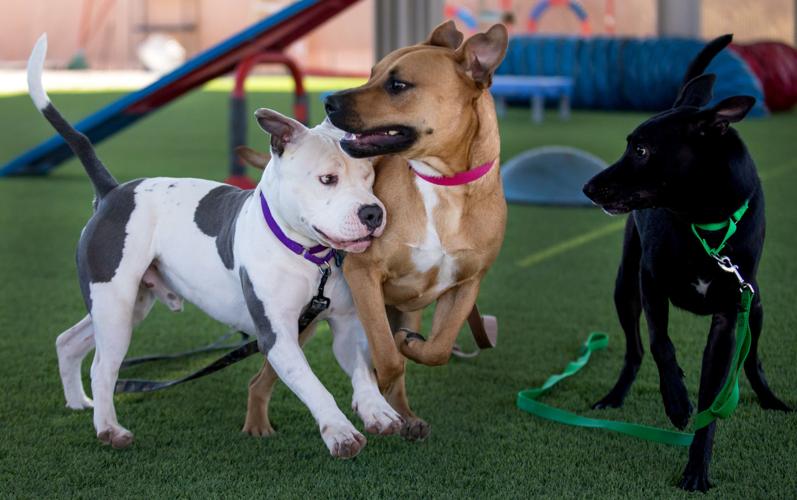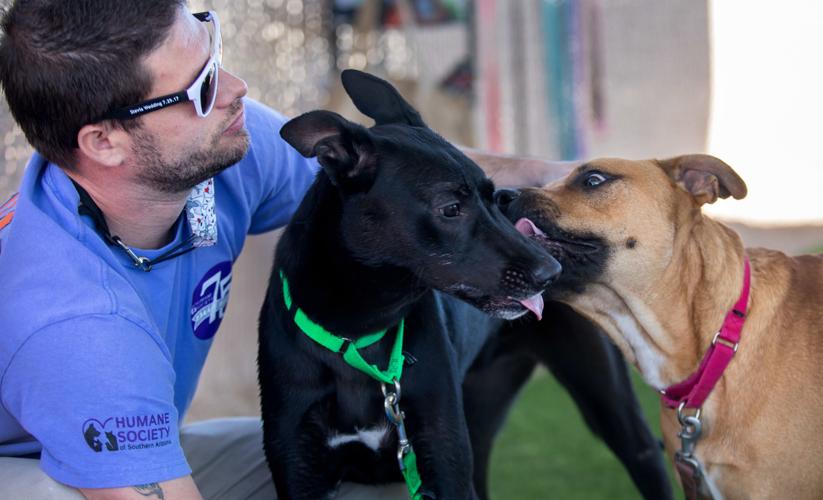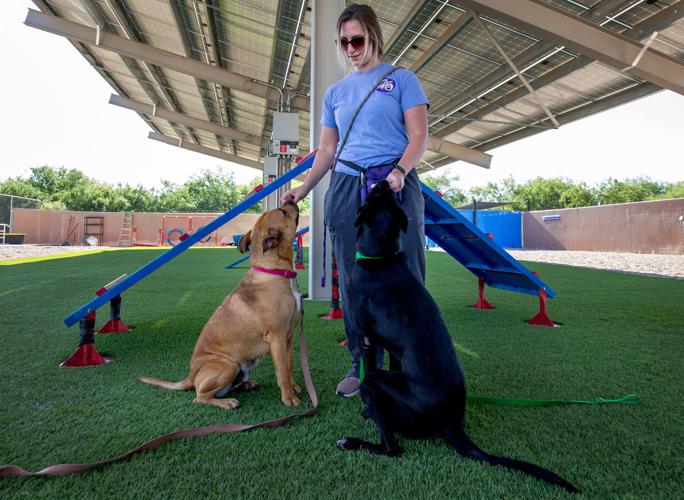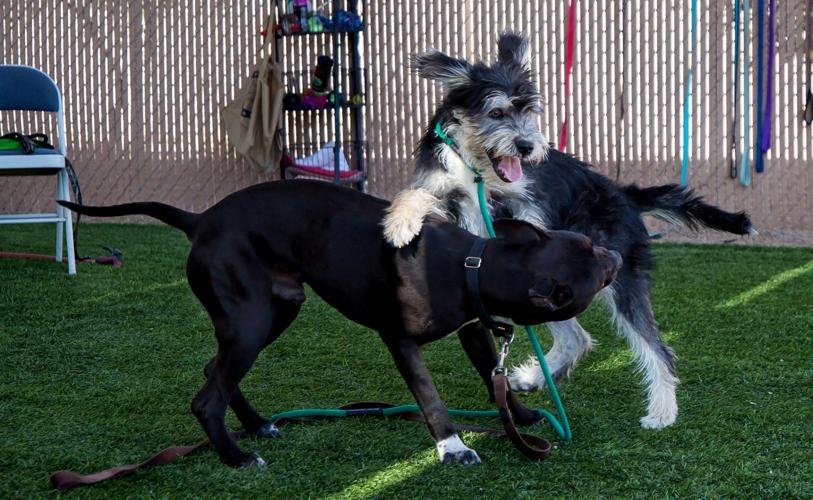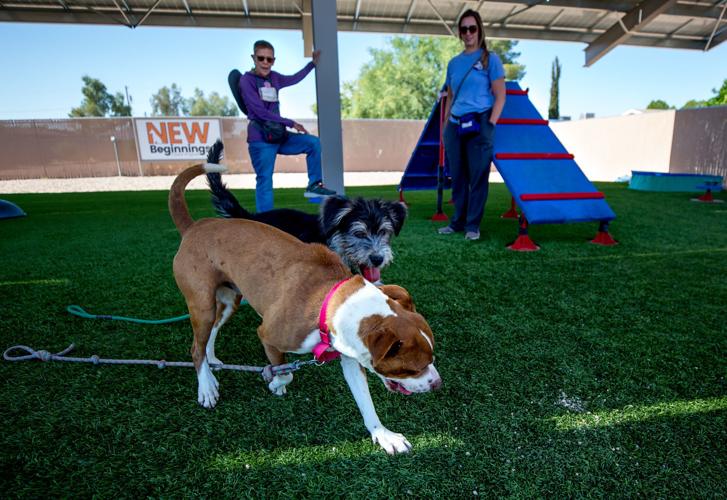A fluffy pup yips and hops on your coworker’s lap during a Zoom meeting. Coos, oohs and aahs ensue.
Hunkering down, working and learning from home during the COVID-19 pandemic means more attention to pets and the need for your furry office pal to adapt to changing circumstances.
One of the silver linings of sheltering in place may be people and their pets forging closer relationships, says Evan MacLean, director of the Arizona Canine Cognition Center.
The Humane Society of Southern Arizona and the Pima Animal Care Center report significant increases in adoptions and fostering pets in the early weeks of the state-ordered shutdown.
The stay-home time allowed shelter pets to acclimate to their new homes, says Kristen Hassen, director of Animal Services of Pima Animal Care Center.
“Dogs are loving this time and contact with people,” says MacLean.
While the bonding time is beneficial and enriching for both pets and people, a change of routines can be stressful and overwhelming for pets, especially ones that are new to a home. Here are some ideas to navigate the coronavirus-triggered togetherness, especially as humans slowly venture out of their homes again.
PETS NEED SPACE TOO
Being around children who want to constantly hug and tug the dog can be too much, says Danielle Hagedorn, canine behavior programs specialist at the Humane Society of Southern Arizona.
Kiddos dash around quickly, make loud, squeaky noises, and are closer to a dog’s eye level, which can be exciting and frightening to the pooch.
Even dogs that have had experience around children can become overwhelmed, says Stephen Szostek, canine enrichment specialist at the Humane Society.
Hagedorn and Szostek encourage parents to watch children and the dog, teach children dog-appropriate behavior, such as how to touch the dog nicely, not pull his fur and stay away from the dog’s face.
Learn your canine’s body language, says McClean.
Tail wagging is a sign of arousal, not happiness, MacLean says.
A dog wagging his tail can be expressing many emotions and does not necessarily indicate his readiness to interact.
Averting eye gaze and turning of the head to avoid looking at you, pacing, salivating, panting and yawning are some indicators that your pet might be overwhelmed or feeling stress, MacLean says.
Give your dog “time out,” suggests Hagedorn. “The whole family has space.”
Whether it is a kennel or a quiet corner, the dog needs space, too.
OVER INDULGING
Like most humans, “dogs love to eat” and feeding is a way of interacting, says anthropologist MacLean.
Too many treats can mean gaining weight, and unhealthy foods and too many human nibbles may cause gastrointestinal problems.
“Don’t overindulge every treat,” says Michael Kaufman, president of the Southern Arizona Veterinary Medical Association
BACK TO WORK
As restrictions ease and people return to work, pets must adapt from 24/7 attention to being left for long periods.
Make the change gradual, says MacLean.
Leave your pet alone for short periods at first and gradually lengthen the time you’re away, suggests Hassen.
If possible, work away from home for half-days or every other day to ease the transition for Fido, MacLean says.
Leave toys to help prevent boredom, says Szostek.
Hassen suggests considering a second pet. Like humans, pets fare better with companionship, she says.
Learn more about your dog and his ability to calm himself by setting up a video recorder in your home, says Hagedorn.
For separation anxiety that results in destructive behavior like ripping and shredding the sofa, Szostek suggests consulting with a professional animal behavior consultant.
“Think about pets like people,” says Hassen. “The more they are socialized, the healthier and happier they are.”
Photos for May 13: Tucson gets by during Coronavirus Pandemic
Tucson gets by during coronavirus pandemic
Updated
The venerable T-Rex outside the McDonald's at Grant and Tanque Verde comes around late, but strong, to the mask game, May 13, 2020, Tucson, Ariz.
Tucson gets by during coronavirus pandemic
Updated
Greg Madril, director of Pascua Yaqui Workforce Development, loads a van up with boxes of food to be taken to homes of elders on the reservation who have isolated themselves during the Coronavirus (COVID-19) pandemic, on May 8, 2020.
Tucson gets by during coronavirus pandemic
Updated
Abigail Pauley (center) and Carmen Solis (right) deliver food to the homes of elders on Pascua Yaqui Reservation who have isolated themselves during the Coronavirus (COVID-19) pandemic, on May 8, 2020.
Tucson gets by during coronavirus pandemic
Updated
Catalina Foothills High School graduates throw their hats in the air as they are videoed on the stage on the football field at Catalina Foothills High School, 4300 E. Sunrise Dr., in Tucson, Ariz., on May 11, 2020. Due to the coronavirus pandemic, Catalina Foothills High School is videoing all 415 graduates individually over three days crossing the stage with their diploma cover. Small groups of graduates are escorted toward the stage and stand next to cones set apart for social distancing. After video and still pictures, graduates are given a t-shirt as they leave. "Its an amazing amount of work and planning, but our grads are worth it," said Julie Farbarik, director of Alumni and Community Relations at Catalina Foothills School District.
Tucson gets by during coronavirus pandemic
Updated
Graduates follow directions as they are filmed cross the stage at Catalina Foothills High School, 4300 E. Sunrise Dr., in Tucson, Ariz., on May 11, 2020. Due to the Coronavirus Disease (COVID-19) and graduations being canceled, Catalina Foothills High School, set across three days, is filming all 415 graduates as they cross the stage with a their diploma cover. Small groups of graduates are escorted toward the stage and stand next to cones set apart for social distancing. After filming and taking pictures, graduates are given a t-shirt as they leave. "Its an amazing amount of work and planning, but our grads are worth it," said Julie Farbarik, director of Alumni and Community Relations at Catalina Foothills High School.
Tucson gets by during coronavirus pandemic
Updated
Catalina Foothills High School senior Maura Benesch grabs hand sanitizer before picking up her diploma cover at Catalina Foothills High School, 4300 E. Sunrise Dr., in Tucson, Ariz., on May 11, 2020. Due to the coronavirus pandemic, Catalina Foothills High School is videoing all 415 graduates individually over three days crossing the stage with their diploma cover. Small groups of graduates are escorted toward the stage and stand next to cones set apart for social distancing. After video and still pictures, graduates are given a t-shirt as they leave. "Its an amazing amount of work and planning, but our grads are worth it," said Julie Farbarik, director of Alumni and Community Relations at Catalina Foothills School District.
Tucson gets by during coronavirus pandemic
Updated
Senior students follow directions as they are videoed crossing the stage on the football field at Catalina Foothills High School, 4300 E. Sunrise Dr., in Tucson, Ariz., on May 11, 2020. Due to the coronavirus pandemic, Catalina Foothills High School is videoing all 415 graduates individually over three days crossing the stage with their diploma cover. Small groups of graduates are escorted toward the stage and stand next to cones set apart for social distancing. After video and still pictures, graduates are given a t-shirt as they leave. "Its an amazing amount of work and planning, but our grads are worth it," said Julie Farbarik, director of Alumni and Community Relations at Catalina Foothills School District.
Tucson gets by during coronavirus pandemic
Updated
A fully suited worker, part of a crew from ServiceMaster, gestures out the door to a teammate while sanitizing the Little Cesars at 1201 W. St. Mary's, May 9, 2020, Tucson, Ariz.
Tucson gets by during coronavirus pandemic
Updated
Owner Michael Elefante cleans the pasta bar at Mama Louisa’s, 2041 S. Craycroft Road. Local restaurants and bars must limit their indoor occupancy to no more than 50%.
Tucson gets by during coronavirus pandemic
Updated
Lunchtime is normally standing room only at R&R Pizza Express, 13,905 N. Sandario Road, Marana. But it was sparsely attended on May 11, 2020, as the state allowed restaurants to re-open their dining rooms. Owner Linda Molitor carefully spaced tables to maintain social distancing for dining-in.
Tucson gets by during coronavirus pandemic
Updated
Owner Linda Molitor wipes down one of four tables available for dining-in at R&R Pizza Express, 13,905 N. Sandario Road, Marana, on May 11, 2020.
Tucson gets by during coronavirus pandemic
Updated
Suzanne Elefante, center, office manager, teaches Breanna Jirschele, employee, a discount at the register at Mama Louisa's, 2041 S. Craycroft Rd., in Tucson, Ariz., on May 11, 2020.
Tucson gets by during coronavirus pandemic
Updated
Debra Roff, left, employee, keeps her distance as she takes a families order at Coyote Pause Café, 2740 S. Kinney Rd., in Tucson, Ariz., on May 11, 2020. Restaurants reopened on Monday after Gov. Doug Ducey allowed restaurants to open and the Pima County Health Department issued a list of protective measures in response to the Coronavirus Disease (COVID-19). Coyote Pause Café has decreased their seating to less than 50% to allow for social distancing along with signage about COVID-19 and social distancing. There are sneeze-guards, made by the employees, at the counter tops. There are also small trash bags placed at every table for customers to place their trash allowing employees to decrease the amount of items they touch.
Tucson gets by during coronavirus pandemic
Updated
Leo Kresch, left, and Drew Burk, employees from Downtown Kitchen and Cocktails prepare to-go meals at The Carriage House, 135 S. Sixth Ave., in Tucson, Ariz., on May 12, 2020. Janos Wilder, owner of The Carriage House and Downtown Kitchen and Cocktails, received a donation to help prepare 1,400 meals for Tucson Medical Center employees. The meal includes two entrees and a desert.
Tucson gets by during coronavirus pandemic
Updated
Devon Sanner, executive chef at The Carriage House and Downtown Kitchen and Cocktails, places Thai Green Vegetable Curry on top of rice in to-go meals at The Carriage House, 135 S. Sixth Ave., in Tucson, Ariz., on May 12, 2020. Janos Wilder, owner of The Carriage House and Downtown Kitchen and Cocktails, received a donation to help prepare 1,400 meals for Tucson Medical Center employees. The meal includes two entrees and a desert.
Tucson gets by during coronavirus pandemic
Updated
A group of finished to-go meals remain on top of the counter while employees from Downtown Kitchen and Cocktails create more to-go meals at The Carriage House, 135 S. Sixth Ave., in Tucson, Ariz., on May 12, 2020. Janos Wilder, owner of The Carriage House and Downtown Kitchen and Cocktails, received a donation to help prepare 1,400 meals for Tucson Medical Center employees. The meal includes two entrees and a desert.
Tucson gets by during coronavirus pandemic
Updated
Rachel Tineo, Tucson Strength ambassador, wipes down equipment at Tucson Strength, 6130 E. Speedway Blvd., in Tucson, Ariz., on May 13, 2020. Tucson Strength has modified aspects of their gym to fit the coronavirus pandemic. Equipment is spaced out to allow for social distancing and equipment is being cleaned after every use by members as well as employees.
Tucson gets by during coronavirus pandemic
Updated
Diana Sestiaga, a manager at DSW, talks with a customer at the store located at 7191 E. Broadway, on May 12, 2020.
Tucson gets by during coronavirus pandemic
Updated
A customer orders a meal during Cucusa's Caribbean Cuisine grand opening at the Tucson International Business Center, on May 12, 2020.
Tucson gets by during coronavirus pandemic
Updated
Bartender Katelyn Williams confirms an order from Briante Brown after he checked the offerings from a photo on her phone while doing sidewalk service at John Henry's bar, May 6, 2020, Tucson, Ariz.
Tucson gets by during coronavirus pandemic
Updated
A bench decorated with a thank you to healthcare workers and first responders in the front yard of a home off N Tortolita Road, on May 6, 2020.
Tucson gets by during coronavirus pandemic
Updated
Frank Marini flashes a heart symbol to the staff at Tucson Medical Center in May. The number of hospital beds available in Pima County hasn’t fluctuated much over the last month.
Tucson gets by during coronavirus pandemic
Updated
Recovered Coronavirus Disease (COVID-19) patient Larry Delf, retired Tucson paramedic and St. Mary's Hospital EMT, waves to family members, friends, nurses, doctors, hospital staff and Tucson Fire Department as they celebrate Delf's recovery at Carondelet St. Mary's Hospital 1601 W. Saint Mary's Rd., in Tucson, Ariz., on May 7, 2020. After a month of hospitalization, Delf is being transferred to a long-term acute care facility.
Tucson gets by during coronavirus pandemic
Updated
While waiting for recovered Coronavirus Disease (COVID-19) patient Larry Delf, retired Tucson paramedic and St. Mary's Hospital EMT, Chevelle Baker, center, granddaughter, holds up a sign with Family members, friends, nurses, doctors and hospital staff to celebrate Delf's recovery at Carondelet St. Mary's Hospital 1601 W. Saint Mary's Rd., in Tucson, Ariz., on May 7, 2020. After a month of hospitalization, Delf is being transferred to a long-term acute care facility.
Tucson gets by during coronavirus pandemic
Updated
David Sounart, vice-president of manufacturing, removes the molds from a batch of Twin Peaks mugs, mugs the company made for the TV series, as HF Coors begins to return to production, May 8, 2020, Tucson, Ariz.
Tucson gets by during coronavirus pandemic
Updated
Esmeralda Islava works with client Caroline Stelmach at Bellaza Beauty Bar located at 1951 W Grant Road #110 during their first day reopened since non-essential businesses began closing due to Coronavirus (COVID-19), on May 8, 2020. "Its weird that there are fewer people but it feels [safer]," Stelmach said about the precautionary changes.
Tucson gets by during coronavirus pandemic
Updated
Melanie has her temperature checked before her manicure appointment at Bellaza Beauty Bar located at 1951 W Grant Road #110 during their first day reopened since non-essential businesses began closing due to Coronavirus (COVID-19), on May 8, 2020. When asked what it is like coming back to the salon since the virus Melanie responded "It's different for sure. Having to sign a waiver and get your temperature checked."
Tucson gets by during coronavirus pandemic
Updated
Stylist Rahnay Curtis with mask on while cutting hair at CDO Barbershop on May 8, 2020, in Tucson.
Tucson gets by during coronavirus pandemic
Updated
Owner Jennifer Ball cuts Carl Arnal's hair at CDO Barbershop on May 8, 2020, in Tucson. Arnal said, "I cheated a little on March 7. My son is a barber." He added, "I started panicking when they talked about (reopening) in the middle of May." When he said down in the chair for a cut, he said, "I will definitely enjoy this one."
Tucson gets by during coronavirus pandemic
Updated
Josh and Meghan Leunen share their helping of lava cake from the bed of their truck while cars still file into the lots at the Tucson Dragway Drive-In Theater Powered by Griffith Automotive Repair & Restoration's showing of Pixar's Cars, May 8, 2020, Tucson, Ariz.
Tucson gets by during coronavirus pandemic
Updated
Isaiah Valdez peers out from the trunk of his car, with two stout table legs providing extra support of the hood, before the start of the night's showing of Cars at the Tucson Dragway Drive-In Theater Powered by Griffith Automotive Repair & Restoration, May 8, 2020, Tucson, Ariz.
Tucson gets by during coronavirus pandemic
Updated
Family members practice social distancing while celebrating mothers day at Agua Caliente Park, 12325 E. Roger Rd., in Tucson, Ariz., on May 10, 2020.
Tucson gets by during coronavirus pandemic
Updated
Wright Elementary School teacher Sheree Garcia packs up leftover items in students' desks for them to pick up, on May 8, 2020.
Tucson gets by during coronavirus pandemic
Updated
Wright Elementary School teacher Sheree Garcia elbow bumps her student Francisco Cruz Silva, 8, as she drops off a computer for him at his family's home, on May 8, 2020.
Tucson gets by during coronavirus pandemic
Updated
Sarah Hemzawi, in Raleigh, N.C., gets to attend the evening meal of her parents Ziad Hemzawi and Raina Kanawati, part of their Ramadan ceremonies at their home, May 7, 2020, Tucson, Ariz.
Tucson gets by during coronavirus pandemic
Updated
Rania Kanawati prays in her living room, part of the adapting to the closing of the local mosques due to COVID19 restrictions, May 7, 2020, Tucson, Ariz.
Tucson gets by during coronavirus pandemic
Updated
Owner Jesus Bonillas measures the distance between tables at the American Eat Co. Small businesses can apply for no-interest loans through the city until Tuesday, May 26.


